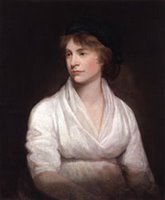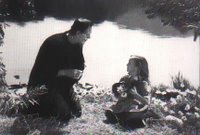--Mary Shelley, Frankenstein
Miranda Seymour’s seemingly definitive biography, Mary Shelley, makes it easy to see Frankenstein’s author as a child, lingering about the adults on candlelit evenings as her father and his friends speculate about the nature of existence. Listening more attentively than the adults in the room might hope, she hears a shocking account from family friend and surgeon Anthony Carlisle about the effect of electricity on the corpse of a criminal.
The man’s jaw “began to quiver, and the adjoining muscles were horribly contorted, and one eye actually opened….the right hand was raised and clenched, and the legs and thighs were set in motion, and it appeared to all the bystanders that the wretched man was on the point of being restored to life.” Fear stopped the experiment, but 13 years later, Mary Godwin would convey that same horror in Frankenstein—“I saw the dull yellow eye of the creature open; it breathed hard, and a convulsive motion agitated its limbs.”
I can also see young Mary hiding under a parlor sofa to hear Samuel Taylor Coleridge recite The Rime of the Ancient Mariner. The lone survivor on his ship, the Mariner cries out how horrible “is the curse in a dead man's eye!” Mary’s most famous book used Captain Robert Walton as its mariner frame, then handed that vision of life in death to scores of interpreters. Most impressive to me is still the work of director James Whale and actor Boris Karloff, who translated it beautifully in the unforgettable scene when the monster is first brought from darkness into the light (a poster I had on my wall as a child). Despite the innumerable liberties Whale and company took with Shelley’s book, they understood the pathos of the monster, the tragedy contained in the horror.
Of course, Mary Shelley’s work was filled with ambitions well beyond the will and the abilities of the early talkies at Universal Studios or even the great director James Whale. She strove to convey her horror of racism, religious prejudice and the slave trade in the treatment of the De Lacey family and Safie, the family's Turkish daughter in law, all of this mirrored in the way the monster is vilified for his appearance. Shelley also took on her disgust with systemic homicide in Justine's wrongful murder by the state. Of course, the corruption of the monster illustrated her beliefs that society shapes the individual, particularly through neglect (an idea that does come through in the Whale movies). On another level, her nightmarish novel embodied her own story of alienation.

After all, Mary Shelley was an alienated daughter of the Enlightenment. Almost unbelievably, her parents met at a dinner party hosted by Common Sense author Thomas Paine. Mary Wollstonecraft was a provocative freethinker who has been called the architect of modern feminism for her 1792 book A Vindication of the Rights of Woman. William Godwin wrote the 1793 volume An Enquiry Concerning the Nature of Political Justice, an argument for an egalitarian society and against such oppressive institutions as marriage, organized religion and centralized government.
Ideas were one thing, the realities of social censure were another, and Godwin married Wollstonecraft in part to cover the illegitimacy of her child (from a prior relationship), Fanny. Though she was fiery and he was more reserved, the two seemed to love each other very much. When Mary Wollstonecraft Godwin died just days after her second daughter, Mary’s, birth, William Godwin was heartbroken.
Little Mary Godwin grew up in an atheist home, consistent with her father and mother’s beliefs, but she grew up in a haunted house nonetheless. Her beautiful mother’s portrait, visibly pregnant with Mary, was a prominent feature in her home, even after her father’s second marriage to Mary Jane Clairmont (which brought Mary two new step siblings, Claire and Charles). Mary learned to write her letters through a daily exercise at her mother’s churchyard tombstone.
Mary and her stepmother never got along, and she longed for the understanding of her dead mother, whose work she read over and over, along with that of her father. At the age of 16, when she met and fell in love with the poet Percy Bysshe Shelley, one of the things that bound the two together was their affection for her parents’ work. Shelley pledged a portion of his inheritance to aid the economically trouble Godwins. They made love for the first time in the churchyard near her mother’s grave, as Seymour writes, “as if Mary Wollstonecraft were presiding over their union.”
But Mary’s father was no longer quite the freethinker whose work she and her lover studied. When he found out about her affair with the married Shelley, he forbade their continued relationship. In the spirit of her anti-authoritarian parents, Mary, along with her sister Claire, ran away to Switzerland with Shelley. By the time the trio ran low enough on money that they were having to walk from Paris to Geneva, Mary must have begun to feel the dark turn her life was about to take.
Over the next three years, she was virtually disowned by her father, and she and Shelley were perceived as pariahs throughout most of English society. Intellectually, she believed in free love, but Mary’s journal writings and letters reveal that she was understandably tortured as a teenage girl at times near destitute and virtually all alone in the world with her lover and his infidelities (which apparently included a fling with Claire).
Furthering her despair, Mary’s first child, Clara, died in her cradle. Though the book Frankenstein was initially conceived in a relatively happy period after the birth of her second child, William, the sufferings deepened yet again when her half sister Fanny, who felt like a burden to everyone in the family, committed suicide. It makes perfect sense that the most powerful horrors of the novel she would write at the end of this period were feelings of alienation, guilt, disgust and loneliness.
Mary Shelley’s intense identification with her monster can’t be escaped. Just as clearly as elements of her lover and her father are embodied in the scientist who abandoned his creation, Mary has much in common with the monster itself, rejected for no better reason than for being the successful product of the scientist’s dreams. Her parents taught her to flout convention and to follow her heart and intellect. In the end, she found herself like that nameless creature who winds up orphaned and adrift on an arctic ice floe. The durability of the novel suggests just how universal such alienation is.
 2018 Note: Recently, the graphic novel (of sorts) Mary's Monster has told this story with unforgettable images and language.
2018 Note: Recently, the graphic novel (of sorts) Mary's Monster has told this story with unforgettable images and language.Pictures above--Miranda Seymour's biography, James Whales' Frankenstein 1931, Mary Wollstonecraft



1 comment:
Hello, I have quoted your blog in my website with a link back to you. See http://british-miniatures2.blogspot.com/2008/09/bone-henry-portrait-of-sir-anthony.html
I hope it is of interest!
Post a Comment